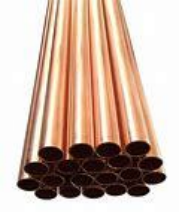1. Introduction
In the past 48 hours, global copper markets have seen increased volatility due to supply chain adjustments in Chile—the world’s largest copper producer—prompting renewed interest in copper-based materials like copper rod and copper bonded earthing systems. With industries from renewable energy to HVAC relying heavily on high-conductivity metals, understanding what a copper rod is and how it’s used has never been more relevant.

Copper rod—often referred to interchangeably as rod copper—is a foundational material in electrical, construction, and manufacturing sectors. Whether you’re grounding a building, welding copper components, or sourcing raw material for bus bars, copper rods play a critical role. This guide breaks down everything you need to know about copper rods, their variants, and how they compare to related products like copper strip and copper tubing.
2. What Is a Copper Rod?
A copper rod is a solid cylindrical bar made from high-purity electrolytic copper (typically C10100 or C11000 grades). Known for its excellent electrical and thermal conductivity, corrosion resistance, and ductility, copper rod serves as a raw material for wires, connectors, and structural components.
- Standard diameters range from 3mm to over 50mm.
- Commonly supplied in straight lengths or coils, depending on application.
- Often confused with copper round bar or round bar copper, though these terms usually refer to the same product in different contexts.
3. Types and Applications of Copper Rod
3.1. Earthing and Grounding Rods

One of the most vital safety applications of copper rod is in earthing systems. An earthing rod copper (also called ground rod copper) safely channels fault currents into the earth, protecting equipment and personnel. Pure copper rods are highly effective but expensive, so alternatives like copper bonded earthing rod or copper clad steel ground rod are widely used.
Copper bonded steel combines a steel core for strength with a thick copper layer for conductivity. Similarly, copper clad earth rod and copper clad steel earth rod offer cost-effective solutions without sacrificing performance. When comparing earthing rod price, copper bonded options often provide the best balance of durability and value.
3.2. Welding and Brazing Rods
For joining copper components, specialized consumables are required. A copper brazing rod or copper to copper brazing rods are designed for capillary action in high-temperature joints. Meanwhile, copper welding rod—sometimes labeled as welding rod copper or copper to copper welding rod—is used in TIG or MIG processes for copper rod welding.
Note: Copper rod for welding must match the base metal’s alloy to avoid weak joints. Using standard rod copper for welding may lead to cracking or poor conductivity.
4. Copper Rod vs. Related Products

4.1. Copper Strip and Flat Conductors
While copper rod is round and solid, copper strip (or flat copper strip) offers a rectangular cross-section ideal for busbars, grounding straps, and electronics. Variants include beryllium copper strip, nickel plated copper strip, and thin copper strips in rolls (e.g., 1mm copper strip or copper strip roll).
Copper strip for earthing is common in substation grounding grids. Prices vary by thickness—such as copper earth strip 25x3mm price—and finish. For DIY or scrap purposes, people often search for ‘copper strip near me’ or ‘best way to strip copper wire’ when repurposing cable sheathing into usable copperstrip.
Important: Burning copper wire for scrap is illegal in many regions and damages the metal. The fast way to strip copper wire involves mechanical strippers or automated machines, especially when stripping wire for recycling.
4.2. Copper Pipe and Tubing
Unlike solid copper rod, copper tubing is hollow and used primarily in plumbing and HVAC. Air conditioning copper pipe (or aircon copper tube) comes in standard sizes like 15mm copper pipe, 22mm copper tube, and 3/4 copper tubing. Proper copper pipe soldering ensures leak-free joints in systems ranging from residential water lines to commercial AC units.
Copper pipe price fluctuates with LME copper rates, similar to copper rod price and copper ingot price. While copper rod is rarely bent like pipe, both require cleaning before joining—whether via resoldering copper pipe or using copper pipe fittings.
5. Market and Practical Considerations
When sourcing materials, buyers often compare copper rod price with alternatives like copper bonded or flexible copper bus bar. For large-scale projects, bulk copper bars for sale—including cu bars and copper flat bar—are evaluated based on conductivity, tensile strength, and cost per kilogram.
Recyclers frequently deal with stripping copper wire for scrap, seeking the best way to strip copper cable efficiently. Meanwhile, fabricators may use copper metal strips or copper edging strip for architectural or electrical detailing.
6. Conclusion
From ensuring electrical safety with an earthing rod copper to enabling precision joins with copper to copper welding rod, the humble copper rod remains indispensable across modern industries. Whether you’re comparing copper clad ground rod options, calculating copper bar top conductivity, or sourcing a roll of copper strip, understanding these materials helps optimize performance and cost. As copper markets evolve, staying informed on specs, pricing, and sustainable practices—like proper stripping instead of burning—will keep your projects efficient and compliant.
Our Website founded on October 17, 2012, is a high-tech enterprise committed to the research and development, production, processing, sales and technical services of ceramic relative materials such as What. Our products includes but not limited to Boron Carbide Ceramic Products, Boron Nitride Ceramic Products, Silicon Carbide Ceramic Products, Silicon Nitride Ceramic Products, Zirconium Dioxide Ceramic Products, etc. If you are interested, please feel free to contact us.

